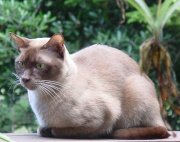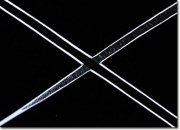Difference between pages "Anthraquinone" and "Cat hair"
(Difference between pages)
Jump to navigation
Jump to search
| Line 1: | Line 1: | ||
| − | [[File: | + | [[File:Burmesecatwp2.jpg|thumb|Burmese chocolate cat]] |
== Description == | == Description == | ||
| − | + | The soft, springy hair from domesticated [[cat]] (''Felis catus''). Some types of cat hair (short white or tips of long, white) have been used in artist brushes. In Asia, cat hair brushes are used for detail work (Pinney 1999). | |
| − | + | * For cat hair identification, see http://cameo.mfa.org/wiki/Category:FRIL:_Cat | |
== Synonyms and Related Terms == | == Synonyms and Related Terms == | ||
| − | + | Felis catus; domestic cat; house cat | |
| − | |||
| − | |||
| − | |||
| − | |||
| − | |||
| − | |||
| − | |||
| − | |||
| − | |||
| − | |||
| − | |||
| − | |||
| − | |||
| − | |||
| − | |||
| − | |||
| − | |||
| − | |||
| − | |||
| − | |||
| − | |||
| − | |||
| − | |||
| − | |||
| − | |||
| − | |||
| − | |||
| − | |||
| − | |||
| − | |||
| − | |||
| − | |||
| − | |||
| − | |||
| − | |||
| − | |||
| − | |||
| − | |||
| − | |||
| − | + | [[File:cathair1large.jpg|thumb|Cat hair]] | |
| + | [[File:cathairlarge.jpg|thumb|Cat hair]] | ||
| − | + | ==Resources and Citations== | |
| − | * | + | * Zora Sweet Pinney, 'A Handle on the Terms used for Artists' Brushes', unpublished glossary, 1999 |
| − | * '' | + | * ''Encyclopedia Britannica'', http://www.britannica.com Comment: "cat, domestic" [Accessed October 16, 2003]. |
| − | * | + | * Wikipedia: http://en.wikipedia.org/wiki/Cat (Accessed Oct. 18, 2005) |
[[Category:Materials database]] | [[Category:Materials database]] | ||
Latest revision as of 08:31, 24 May 2022
Description
The soft, springy hair from domesticated Cat (Felis catus). Some types of cat hair (short white or tips of long, white) have been used in artist brushes. In Asia, cat hair brushes are used for detail work (Pinney 1999).
- For cat hair identification, see http://cameo.mfa.org/wiki/Category:FRIL:_Cat
Synonyms and Related Terms
Felis catus; domestic cat; house cat
Resources and Citations
- Zora Sweet Pinney, 'A Handle on the Terms used for Artists' Brushes', unpublished glossary, 1999
- Encyclopedia Britannica, http://www.britannica.com Comment: "cat, domestic" [Accessed October 16, 2003].
- Wikipedia: http://en.wikipedia.org/wiki/Cat (Accessed Oct. 18, 2005)


